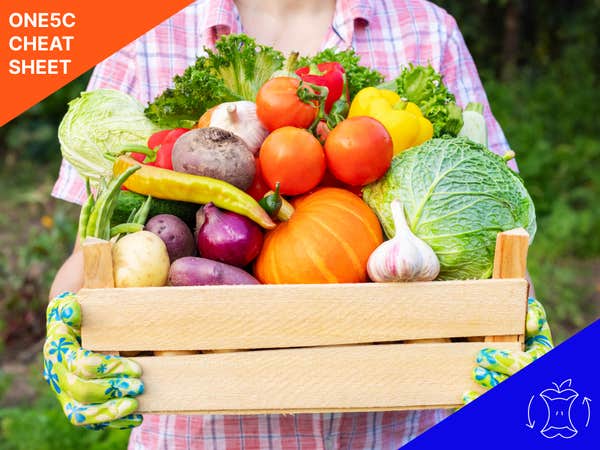Hey team, and welcome back to one5c! We’ve said it before, and we’ll say it again (and again), but food waste takes the gold on the podium of “shouldn’t-be-a-problem” climate problems. Granted, the entire system needs an overhaul, and the livestock industry plays an outsized role in overcooking the planet. Food waste, though… Food waste is an everyone problem, and that’s a wonderfully empowering thing. That’s particularly true this time of year, when we’re in the sweet, ripe part of the produce season.
If you’re like me, your eyes tend to be way bigger than your fridge when farmers’ markets are at their peak. And that leaves you racing the clock against spoilage. Fortunately, Liza, one of our contributors serving up sustainable deliciousness over at Cool Beans, has baked all the fruit-and-veggie-saving know-how you need into a single page. Print it, stick it to your fridge, and share it with anyone you’ve ever seen toss a rotten apple. —Corinne
HOW TO EXTEND THE LIFE OF YOUR PRODUCE—AND FIGHT FOOD WASTE
By Liza Schoenfein

When your potatoes sprout beady little eyes that stare at you in judgy condemnation, you accept your guilt and toss them. Same goes for the mushy avocado, floppy carrots, and half-bag of lettuce that went slimy—again. It happens every day. Literally. American households toss close to one-third of the food they buy, and produce makes up the biggest piece of that pie, accounting for more than 27% of the vittles U.S. homes send to the trash heap, according to ReFED, a national nonprofit focused on food waste solutions.
All that chucked grub is a major source of planet-warming gasses, particularly methane, which is why tossing less food is the one of the top two actions everyday folks can do to address the climate crisis. It’s also why we crammed our best produce-saving know-how into a single handy chart.
Keeping fresh fruits and veggies out of the bin often boils down to knowing the ideal way to store, wash, and preserve ‘em. Moisture and microbes are the big baddies here, because they’re both drivers of food spoilage. Plus, there’s also ethylene, a ripening gas that some fruit and veg give off and others are sensitive to—causing them to go from ripe to rotten before you can say “slimy scallions.” That’s why it’s best to keep the emitters away from the producers, which, yes, can get complicated.
You’ll find all the best practices organized for you in this printable cheat sheet: what to separate, when to wash, how to store and freeze, and even our favorite “oh crap, those berries are about to go” ideas for salvaging vittles even at the last second.
Liza Schoenfein is a core contributor to Cool Beans and a longtime food editor and writer. She’s been executive editor of Saveur and a contributor to Epicurious, Civil Eats, and more. She writes about iconic Jewish ingredients for The Forward and blogs about food and gardening at lifedeathanddinner.com.
SPONSOR

Restore the Planet, One Mission at a Time
The responsibility to protect our planet falls on all of us. Planet Wild is a community of nature lovers pooling their contributions to fund efficient projects that save animals, oceans, and forests. And you can join them. Each month, your contribution will help fund a targeted nature revitalization mission where it’s needed most. With monthly videos, you’ll even get to see the impact you’re making.
The first 150 people to sign up via the link (coupon code automatically applied) will receive the first month for free as a special offer from us.
THE ROUNDUP
In the news this week
Newsweek revealed the winners of its Readers’ Choice awards, and the fast-food chain topping the list is plant-based patty joint Next Level Burger. The chain, which has nearly 30 locations nationwide, outranked stalwarts like Chick-fil-A, Popeyes, and In-N-Out Burger. McDonald’s and Burger King didn’t make the cut.
Air New Zealand is scrubbing its target to cut carbon intensity by 28.9% below 2019 levels by 2030. The airline said its ambitions were tempered by the “the affordability and availability of alternative jet fuels.” The announcement shines a harsh light on the struggle of the entire aviation industry to meet its green ambitions. Sustainable fuel makes up only 0.5% of the supply, and wait times for more-efficient next-gen jets are lengthy, Bloomberg reports.
Solar and wind energy supplied 30% of electricity demand in the E.U. in the first half of 2024, surpassing fossil fuels for the first time, according to a new report from the firm Ember. If you add in other renewable sources like hydropower, the total jumps to around 50%. Burning dead dinosaurs, by comparison, contributed 27% of the block’s electrons. “We are witnessing a historic shift in the power sector, and it is happening rapidly,” Ember analyst Chris Rosslowe told The Guardian.
New research in the journal Frontiers of Science is sounding the alarm on methane emissions—loudly. The authors found that CH4 emissions are rising at the fastest rate in decades, and curbing them is essential to addressing near-term temperature spikes. The potent gas is responsible for half of current planet-heating impacts, as it has 80 times the warming potential of CO2 in its first two decades in the atmosphere.
No one’s really sure if plug-in hybrid EVs are the “bridge” solution they’re made out to be. That’s because we don’t know if drivers are using the cars in the way automakers intended. Owners are supposed to plug overnight and use the car’s onboard battery to get through most day-to-day errands, only tapping into the gas tank when that juice runs dry. Automakers, however, aren’t sharing the data on how much drivers actually plug in and use the vehicles this way, reports InsideEVs.

